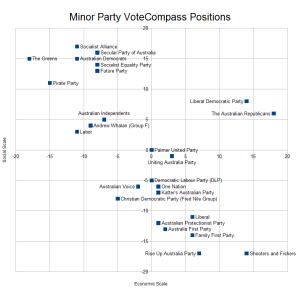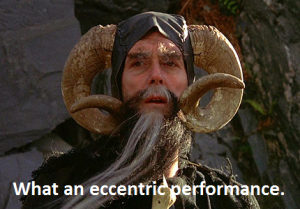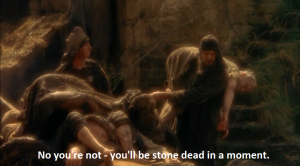We have the wingnut right represented by the Rise Up Australia Party:
The wingnut left represented by the Socialist Equality Party:
And the just plain wingnut represented by the Palmer United Party (sadly the tinfoil hat wearing Citizen’s Electoral Council is not running in NSW):
Meanwhile One Nation and The Democrats are still here:
All this and some rather dodgy preference deals leaves a below the line voter, like myself, with a hard task ahead of me. Who do I preference first? Who do I preference last? How do I order everything in the middle?
So I’ve gone and run the minor parties through the ABC’s Vote Compass website to see where they stand on a more numerical basis. Of all the groups and independents there are 25 who have a broad enough issue base (and websites to have a look at their policies) to work here. There’s a bunch of single issue parties, which are easy enough to consider separately (although some, notably Stop the Greens and Smokers Rights, seem to be nothing more than fronts for the libertarian Liberal Democratic Party).
Firstly I’d like to say that the condition of policy information on parties’ websites is woeful (the Socialist Equality Party’s material isn’t even on its own website – it sits on the site operated by the International Committee of the Fourth International, a global Trotskyist organisation). In most cases its poorly organised, badly written or strings of motherhood statements. Everyone could really lift their game. Nevertheless I managed to divine party positions on many of the Vote Compass questions using policy statements and other resources (such as media releases) on party websites.
Here’s where they’ve all come out (I’ve used the Vote Compass rankings for the three major parties) – the scale is the same as vote compass – economic issues on the x axis and social issues on the y axis:
 |
| Click for a larger version |
Firstly the error bars on these are pretty large as many policy questions had to be answered with an “I don’t know”.
Secondly the set of questions, whilst relevant to current policy debates, hardly covers the full gamut of party policies. The answers also don’t cover the full range of policy responses either. A different system produces different results.
For example Socialist Alliance should really be further to the left of the Greens (and the Socialist Equality Party further to the left still). They wind up being further right as they want to eliminate government assistance to big business (like car manufacturers) – by nationalising them (there’s not really an appropriate answer for this on the question).
Similarly a number of the ‘micro right’ parties should really be further left on the economic scale given their position on protectionism, but slide right due to their opposition of a few labor government taxation policies.
Other have views that are a little bit over the shop on the traditional scales, e.g. protectionist of agriculture but deregulate small business or; against same sex marriage but supportive of euthanasia.
I also feel like the questions were designed to maximise the difference between the ALP and the Coalition (the reality is that there is much policy they share in common), so what are really fringe parties ideologically may sit much closer in to the main parties.
So take these rankings with a large grain of salt okay?
However this does allow us to put these parties into groups.
The ‘Pick a policy from everywhere’ Centrists
Hard to characterise as left or right in general, they pick issues from both sides.
- Palmer United Party
- Uniting Australia Party
The Big Government Christian Conservatives
Protectionist economics combined with conservative christian values.
- One Nation
- Christian Democrat Party
- Australia Voice
- Democratic Labor Party
- Katter’s Australian Party
The Small Government Christian Conservatives
Small government (in terms of taxation, spending and regulation) and christian values.
- Family First
- Rise Up Australia Party
- Shooters and Fishers
The Nationalists
Very protectionist economics and conservative social values (though these take a lower priority)
- Australian Protectionist Party
- Australia First Party (though these guys are pretty extreme, they’re more fascist – if you forgot about social issues they’d get on pretty well with the Socialist Equality Party)
The Libertarians
Small government (in terms of taxation, spending and regulation) and social freedoms.
- Liberal Democrat Party
- The Australian Republicans
The Moderate Progressives
Balanced regulation and taxation with limited social freedoms.
- Australian Independents
- Andrew Whalan (Group F)
The Social Progressives
Social freedoms and large (in terms of taxation, spending and regulation) but more accountable government.
- The Pirate Party
- The Future Party
- The Secular Party
- Australian Democrats
The Communists
Nationalise everything, workers rights and social freedoms. (Also keep an eye out for ex-communist party members – which has been deregistered – running as independents, such as Ron Poulsen in NSW)
- Socialist Alliance
- Socialist Equality Party
Want to find out more about the minor parties – read some excellent summaries here, here and most comprehensively here and here. Happy voting!




Xanthë
August 27, 2013 at 08:15Really good work, and I loved the MP&tHG illustrations. I’m in Victoria and have a slightly different perspective since two of our last three elections have resulted in nutters being elected to the final Senate seat, so I had a good long rant about the Group Ticket Voting: https://creatinganxiety.wordpress.com/2013/08/20/rise-of-the-nutters/ In lieu of what you’re doing, which is to analyse their policies through the ABC’s Vote Compass, I instead tried to examine who each of the parties are friendly with as likely giving some insight into what their priorities are and what they’re standing for. And while NSW has the nadir of 110 boxes to fill out below the line, further south we’ve got no less than five ridiculous parties who didn’t submit a GVT at all, which means they can’t get an above the line vote — there would be no indication of how to validly distribute their preferences!
Anonymous
September 1, 2013 at 03:02Where is your reference to the Australian Sex Party? They've been around for a few years now!
Minor Parties Vote Compass, Australian 2016 Federal Election | Software / Wetware
July 26, 2016 at 13:30